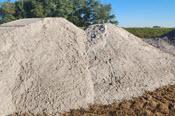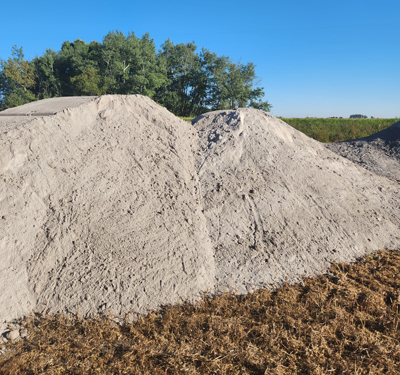
Your crop & your soils could benefit from more calcium
By Stacy Berry
Calcium is an essential nutrient that has been slowly depleting from Canadian soils over the years, and it’s possible that your farm is starting to feel the lack.
What is calcium? According to Morgan Duggan, the head agronomist with Norstar Agriculture in Edmonton, Alta., “calcium is a lot of things, but overall, it’s a macronutrient that is required to grow a crop.”
Like calcium is good for bones in humans, it also has “a big role for the ‘bones’ of the plants – like the cell walls, membranes, and plant structure.”
Nutrients are considered either micro- or macronutrients and are categorized by the amount needed in the crop. As their names imply, micronutrients are needed in tiny amounts, and macronutrients are needed in large amounts. Calcium is considered one of the six macronutrients: N, P, K, S, Ca, and Mg.

If it’s a macronutrient, why is it not always included with regular fertilizer blends in Canada?
Duggan explains that “here in Canada, we broke the land pretty recently – about 100 years ago. The calcium numbers in the soil held up really well until the last couple decades, so we never needed to add it back into the soil.” However, regular removal of a nutrient without replacing it will eventually lead to a deficit, no matter how much you start with.
“We are starting to see that deficit now.”
What does that deficit look like? Turns out, calcium deficiency is pretty subtle.
“You don’t actually see the calcium deficiency outside of a tissue sample, or low pH in a soil sample,” explains Duggan. “You might see deformities in new growth, but often you’ll mostly see other nutrient deficiencies.”
How does a lack of calcium cause other deficiency symptoms?
That’s because one of the many roles calcium plays in the plant is “regulating the uptake of other nutrients. Calcium is also a messenger in the plant,” says Duggan. This means that when calcium is low, other nutrients are not being taken up, and are not moving throughout the plant properly. And you will begin to see other deficiencies.
This is where soil sampling comes in handy – you need to know your starting point, before you can decide if adding calcium or other nutrients would help.
There are two ways to measure how much calcium you have in your soil: Parts per million (ppm) or base saturation. Ppm is measured exactly as it is named – how many parts in a million are calcium. Base saturation is a little more complicated.
To understand base saturation , you must understand cation exchange capacity (CEC). Cations are positively charged ions, like calcium (Ca2+) or magnesium (Mg2+). Cations are both floating in the soil solution and attached to soil particles. These cations can change places with each other – hence the term cation exchange. Therefore, CEC is the total amount of cations attached to negatively charged soil particles that can be exchanged with the cations dissolved in the soil water.
You get your base saturation when you take the sum of all the base cations you are measuring for (in this case, calcium), divide it by the CEC value, and express it as a percentage.
Duggan prefers to measure calcium through base saturation: “There is lots of debate over which is a better measure, but I find base saturation does a better job of showing how much calcium is actually available.”
In most of the soils Duggan has dealt with, the calcium base saturation hovers around 30 per cent – and agronomists want to see over 65 per cent. That means that those soils need a fair amount of calcium to get that increase, and therefore, liming is usually the way to go – applying tons per acre, rather than pounds. Lime is used interchangeably as a term for any high calcium material that can be applied to soils.
According to Duggan, liming can be seen through the lens of either nutrients or pH. “I define liming as applying calcium as a nutrient. Other people see it as applying lime to increase the pH.”
This is because calcium plays a role in the soil itself. “Calcium keeps things in balance,” says Duggan. “It’s important for buffering, and increases soil pH.”
There is another – often underrated – role that calcium can play in the crop, and that is disease suppression.
One disease where this is being considered is clubroot. Dr. Stephen Strelkov, professor of Plant Pathology at the University of Alberta, is a clubroot expert. “Clubroot is a soil-borne disease of Brassica species, like canola. The pathogen, Plasmodiophora brassicae, is difficult to control because it produces a lot of resting spores that can persist in the soil for years,” explains Strelkov. “Clubroot forms large galls that interfere with nutrient and water uptake, leading to poor plant growth, low yield, and early senescence (plant death).

“We are still working to distinguish the effects of calcium specifically versus increased pH, but both increased calcium and increased pH have been hypothesized to reduce clubroot,” says Strelkov.
How does pH or calcium suppress clubroot?
Generally, of course, a healthy plant withstands disease better than an unhealthy plant, so having adequate calcium and a closer to neutral soil pH helps ensure a healthy crop.
Although the specific cause hasn’t been conclusively identified, “either the presence of calcium and/or the increase in pH can inhibit resting spore germination and reduce the formation and maturation of primary zoosporangia (resulting in a decrease in primary and secondary ‘zoospores’, which are mobile spores that can swim through soil water and infect the plant roots). As well, adequate calcium can reduce the post-penetration effects of clubroot on the plants,” explains Strelkov.
That’s well and good, but does it actually work?
According to Strelkov’s studies, “two recent graduate projects (conducted by Nicole Fox and Brittany Hennig) looked at pH increases from liming and clubroot suppression, and some significant clubroot reduction was seen.”
Strelkov advises agronomists and farmers against rushing into large management changes though. “Using calcium to control clubroot can be a finicky solution, sometimes yielding inconsistent results. Its efficacy depends on several factors, including timing of seeding and lime application versus when it rains; amount of rainfall; and the type of soil you have.”
Genetics of the pathogen may also play a role and this was the focus of a recently completed research project. “It appears that not all strains of clubroot react the same way to liming, with some being more sensitive than others, which further complicates the effectiveness of this strategy as a tool for clubroot suppression.”
Overall, calcium and pH play a role in disease management, but Strelkov cautions farmers that, “using calcium or liming to control clubroot is far from foolproof. Its efficacy can be unpredictable, and it can also be expensive.”
Options such as plant genetics, increased rotations, and cleaning equipment are more reliable management methods. Soil nutrition is important but should be used to augment a disease management plan, not be the basis of one.
It's pretty clear that calcium plays an important role in the agronomy of a crop, and that deficiencies cost farmers over time. What holds farmers back from applying calcium?
The short answer? “Money,” says Duggan. “It’s expensive to lime. Historically, companies had to buy calcium products out of province, and it could cost up to $1,000 per ton.” Yes, you read that right.
“At those prices, you may as well buy a new piece of land with fresher (calcium) reserves.”
On top of the cost, there are “limited products available in Canada,” adds Duggan. Because of product undersupply, calcium was often not at the forefront of the minds of agronomists and farmers. However, calcium is becoming increasingly more visible.
A few more products are out there, and prices are becoming more reasonable. Eventually, it may start to cost producers more to avoid the cost of calcium application.
It never hurts to ask your agronomists about calcium products that may be available, and consider taking some soil samples to see where your own soils are at.
After decades of mining calcium without replenishing it, it’s time to ask our soils, “Got milk?” BF



Post new comment